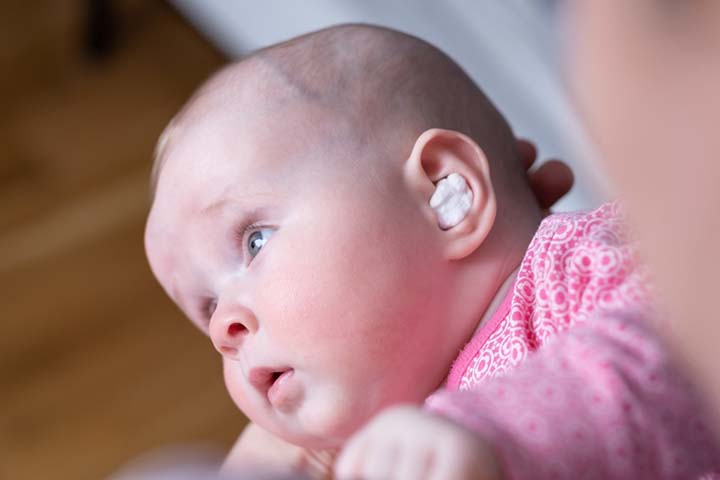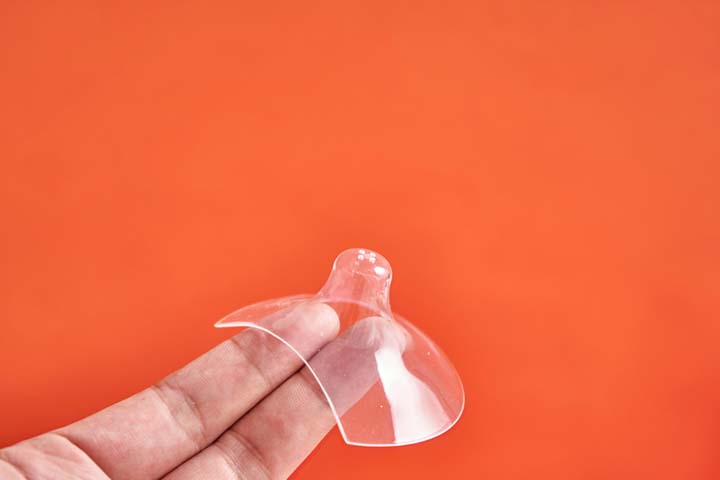Breast milk alone can fulfill an infant’s nutritional needs; therefore, exclusive breastfeeding is advised until a baby turns six months old (1). In most cases, babies are fed from both breasts. However, you may notice that your baby sometimes may prefer breastfeeding from one breast. For most women, one-sided breastfeeding is a typical condition. An infant may prefer one-sided breastfeeding for a variety of reasons. Read through this post to learn more about one-sided breastfeeding, its causes, negative effects, and ways to deal with it.
Causes Of One-sided Breastfeeding
The following factors can be the reasons for one-sided breastfeeding (2):
- Uncomfortable feeding position:Babies may prefer one breast if they are not comfortably held to latch on the other breast. Always follow the right breastfeeding techniques and positions
- Ear infection or stuffy nose: This may cause discomfort to the baby to feed on one side.
- Lack of milk supply: Sometimes, women may have less milk supply on one breast. Also, women who have undergone breast surgery, which involves removal of glandular tissue, may not have enough milk in that breast. There is a possibility that the milk flow is slower or more forceful. That also can affect a baby to prefer a particular side leading to unbalanced feeding, besides milk supply.
- Nipple trauma or cracks: If this happens to one breast, mothers may prefer to feed the baby on the other breast.
- Recurrent mastitis or blocked ducts: This may cause soreness or pain to feed on the affected side, and the mother may prefer the baby to feed on the other breast.
- Physical disability: Some women may find it difficult to hold the baby on one side due to physical problems.
-
- If baby has side preference, possibly due to position in utero, like breech, or use of forceps during delivery, he or she might be reluctant to turn the head toward a particular side.
One-sided Breastfeeding: Does Your Baby Get Enough Milk?
Your baby can get enough milk through one-sided breastfeeding if you let them wean at regular intervals. However, if there is less supply of milk on your breast or if you do not feed often, your baby may not receive adequate milk. This could usually impact babies who are less than six months old and exclusively fed on breastmilk.
The following signs suggest that your baby is receiving enough milk (3):
- At least five fully wet disposable nappies or six fully wet cloth nappies in 24 hours
- Odorless and clear urine
- Runny bowel movements
- Increase in weight, length, and growth circumference
- Good muscle tone
- Normal skin color
- Normal skin turgor; you may check this by gently pinching and releasing the skin from the abdomen and see how it goes back to normal.
Note: Contact your healthcare provider if you are concerned that your baby is not getting enough milk through one-sided breastfeeding.
Side Effects Of One-sided Breastfeeding
One-sided breastfeeding may cause certain problems in some women. Both breasts can have different problems as one is not used, and the other is overused. One-sided nursing may result in (4):
- Cracked nipple: This is one of the major problems that you may face if your baby is breastfeeding from one breast alone. One nipple may become painful and cracked due to continuous sucking.
- Painful breast: You may feel pain on both breasts. While one breast could cause you pain due to the cracked nipple, the other breast might cause you pain due to engorgement.
- Engorged breast: This happens on the less-preferred breast. The breast may become hard and painful due to the excess milk., and the nipple may become flattened and tight, leading to leaks.
- Blocked duct: The failure to remove milk from the less-preferred breast may cause the blockage of the milk ducts. You may also notice a painful lump and redness on the breast.
- Mastitis: This is the inflammation of the breast due to milk stasis (restricted milk flow). Initially, mastitis can be noninfective, but if it persists, it could cause bacterial superinfection. Mastitis is a common infection among breastfeeding women. According to the National Health Service (NHS) Lothian, lactation mastitis affects approximately 10% to 33% of women who breastfeed, with the highest occurrence observed within the initial two to three weeks after childbirth. The condition may also occur due to the infection of the cracks or fissures on the preferred feeding breast.
- Breast abscess: This is a painful swelling and pus formation on the breast. It occurs if mastitis is not managed correctly.
Certain side effects of one-sided breastfeeding, such as lopsided (uneven) breasts, are not a serious concern. However, you may have to be careful to avoid soreness or cracks on the nipple. The non-preferred breast should also be taken care of to prevent milk stasis and other complications. Seek medical attention if you notice any of the problems mentioned above.
How To Encourage A Baby To Nurse From Both The Breasts?
It is always good to feed the baby from both the breasts, unless it is physically not possible for you. If you do not experience any pain, bleeding, or severe cracks in either of your breasts, you may encourage your baby to breastfeed from both the breasts, by following these tips:
- Offer the less-preferred breast initially or when they are sleepy; do not force them.
- Massage the less-preferred breast and let the baby suckle on both breasts for effective nipple stimulation; this may enhance blood supply.
- You may offer the less-preferred breast after they feed on the preferred one. They may accept it if there isn’t enough milk on the preferred breast.
- You may use a nipple shield if the shape of the nipple is the cause.
- You may change the feeding position.
- You could try sliding the baby from prefered side to non prefered without changing head position. It’s helpful if the baby is reluctant to turn the head to the certain side because of position in utero or use of forceps or torticollis. A gentle massage in the jaw and neck area should help, and if not resolved, a visit to a chiropractor specializing in infants could help.
If your baby is not latching on or has an aversion to breastfeeding from one breast, contact your healthcare provider to know the reason behind it.
Will Your Breasts Look Lopsided?
You may notice lopsided or uneven breasts if your baby feeds from one breast alone. The breast that your baby feeds on may look more prominent than the other one.
Even those women who generally feed their babies on both breasts could have uneven breasts after feeding their babies on one breast.
The unevenness may also occur if the milk production rate is different on both breasts.
The lopsidedness of breasts is normal in lactating mothers, and it is more noticeable during the first few weeks after delivery. Although some women may have a concern about the unevenness, it is unlikely to be noticed by other people in most cases (2).
When To Call The Doctor?
You should contact your healthcare provider if you notice any of the following symptoms when feeding from one breast at any time during the lactation period:
- Breast or nipple pain
- Chronic breast/nipple soreness
- Bleeding from the nipple
- Cracks or fissure in the nipple
- Red, tender lumps on the breast
- Orange peel skin texture
- Low milk supply (low letdown)
- Baby passing less urine
- Poor growth of the baby
Your doctor may diagnose the cause of one-sided breastfeeding and make relevant recommendations. They may also prescribe additional formula foods to your baby if there is not enough milk production.
Tips For Breastfeeding On Only One Side
If you are into feeding your baby from one breast alone due to some health problems or other reasons, the following tips may help you to reduce the risk of possible side effects:
- If you can breastfeed from both sides, you may alternate the breasts on each feeding. This could make both breasts stay healthy.
- Feed your baby often.
- If you are feeding your baby on one breast alone, pump the milk from the other breast to avoid engorgement.
You may use nipple creams for cracks as per your doctor’s recommendations. You may also give a gentle massage to the baby’s less-preferred breast to avoid engorgement.
Sometimes, your baby may prefer one-sided feeding for a few days due to blocked nose, ear infection, or pain and tenderness of the arm after vaccination. This is temporary, and they will start feeding on both breasts after recovering.
If you prefer to feed the baby on one side alone, you may have to try pumping milk from the other breast to avoid engorgement and mastitis.
Breastfeeding from one side may cause issues, such as breast engorgement, blocked duct, and mastitis. Besides, research shows that breastfeeding from one breast (unilateral breastfeeding) raises a mother’s risk of developing cancer in the unsuckled breast in post-menopausal women (5). Thus, experts encourage mothers to breastfeed from both breasts unless there’s a physical or medical issue. But if that’s not possible, unilateral feeding can also meet your baby’s nutrition requirements when fed often
Key Pointers
- Some babies may show a preference for one breast over the other due to various reasons.
- Reasons for one-sided breastfeeding may include uncomfortable positions, ear infections, low milk supply, nipple trauma, and physical disabilities.
- One-sided breastfeeding may lead to several side effects such as cracked nipples, painful and engorged breasts, blocked ducts, mastitis, and breast abscess.
- To encourage nursing from both breasts, try offering the less-preferred breast, using massage, nipple shields, and different positions.
- Consult a doctor if you experience pain in the nipples or breast, bleeding, cracks or fissures, lumps in the breast, the baby passing less urine, and poor growth of the child.
Don’t worry if your baby only wants to feed on one side. We’ll discuss why this is normal and how to ensure your baby is getting enough nutrition.















